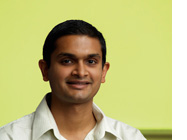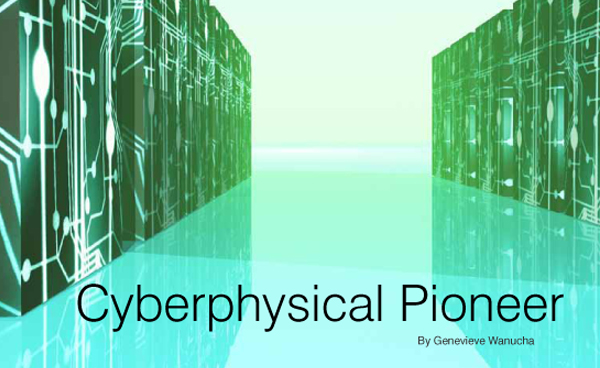It's not everyday that a lab develops a new science. But that's exactly what's happening at LIDS, where research scientist Ketan Savla is building the theoretical foundation of what he calls cyberphysical science. "Only in the last decade or so has wireless technology boomed," he says, "so the idea of machines talking to each other is only now becoming reality." Over the three years Ketan has spent at LIDS designing controls for complex, multi-agent systems, he has developed a unique insight: we now have enough technology that researchers can begin to develop theories to use those tool right.
Ketan works with technologies in the form of robots and sensors, whole swarms of them, and he designs protocols by which these robots can sense the environment and talk to each other. To do so, he programs them with algorithms so they can take collective action to manipulate complex, large-scale systems of interest. These systems, such as electrical grids or transportation networks, are becoming more and more complex, which means that ultimately, robots of the future will need the ability to divide a task between each other, and then autonomously function within the system. They will need to manage pick-up and delivery services, Ketan suggests, and even move people doorstep to doorstep in congested cities.
Autonomous robot action has already begun to help humans manage complex tasks, such as forest fire monitoring. In the usual situaest. They measure the local temperature and send a signal to a central command unit upon sensing a fire. But these unsophisticated devices too often send false fire alarms, triggered by heat from sunlight. Robots have started to solve this problem. These unmanned vehicles can travel to the location of an alarm to assess an actual fire, eliminating any unnecessary, expensive, or potentially hazardous human interventions.
Ketan's work, however, aims to take this technology to its next phase by applying it to more complex situations. Traffic networks are, for instance, perhaps the best example of a potential application for Ketan's control algorithms. Citywide traffic networks have no single human command center that directs traffic flow – performance is governed by the decisions of individual drivers. Drivers must react to accidents and other obstacles, but since they do not have the information to make the most informed decisions, their collective actions can bring traffic to a standstill.
Ketan thinks that traffic level sensing technologies could inform individual drivers of upcoming obstacles through devices. Of course, people will have to decide whether they want monitoring devices inside their vehicles, or stationed on the roadside. Ketan predicts these kinds of innovations would produce a win-win situation, decongesting roads and drastically reducing all that fuel we waste standing in bumper-to-bumper traffic. But way before engineers can implement traffic flow monitoring, researchers like Ketan must first truly understand decision making in complex traffic dynamics.
For a couple of years now, Ketan has been mentoring a group of computer science Masters of Engingeering students in this exact transportation problem. The students get material for their own software development, while contributing ideas to the control of traffic levels in cities. Directed by Ketan, they have developed an interactive virtual environment called Virtual City Testbed. The testbed allows people to log on and maneuver virtual cars along streets and around flaming traffic accidents just like drivers in a real traffic network. Eventually, the group will gather enough data on peoples' decision patterns to build a theory as to how drivers make decisions in different scenarios.
Prior to joining LIDS, Ketan earned his PhD from the University of California in Santa Barbara focusing on single robotic systems. As he worked, he noticed a huge surge in interest in simultaneous control of multiple robots. The cross-disciplinary nature of this enterprise fascinated Ketan. "That's what really started me off—the opportunity to…marry ideas from controls to operation systems and computer science," he says. When it came time to choose a place for post-doc work, the diverse research methods of LIDS sealed his decision. "The environment here is bubbling with lots of new ideas from different disciplines," he says. LIDS offered him the perfect combination of freedom and motivation to push beyond his doctoral research and branch out to make new connections between research areas.
As important as multi-disciplinary approaches have been to the new world of complex multi-agent systems, simply merging ideas from different specialties is not enough to solve real challenges. New mathematical solutions may spring up one by one in different control systems labs, but how can researchers determine the best one to fill a knowledge gap or respond to a technological challenge? There is currently no efficient way. Ketan thinks a new cyberphysical science could provide a nuanced answer.
Ketan is working to devise a theoretically sound "fundamental benchmark," which is a standard way to compare different solutions to find the one that pushes towards the natural limitations of the complex system. For example, there is a limit to the amount of drivers a road network can handle. An optimal solution to a traffic flow problem will maximize the network's capacity, without overloading it. A benchmark will enable LIDS researchers to locate best-performing, simplest algorithm among multiple possibilities, rather than shoot in the dark.
This kind of work is not practiced much because, simply, it's difficult. "Defining those limits is very hard, and it takes much more work than just coming up with one solution," Ketan says. "Here at LIDS, we do not to just adopt a piecemeal approach, taking some ideas from this discipline and some ideas from that, and tie them up in some way, and solve the problem. No—I think what we are trying to do here is develop new science at the interface of traditional domains." It's rigorous work, and Ketan emphasizes that it takes years of deep thinking to wrestle with a theoretical problem, but it's worth it. The cyberphysical science emerging from LIDS offers the possibility of pinpointing real, implementable solutions to challenges as pressing as the safety of our highways and forests, and as practical as saving gas money.




